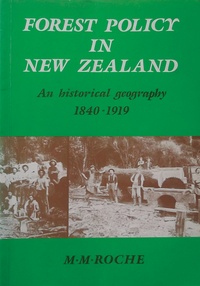A changing field of literature
John P. Adam PHANZA, landscape historian and heritage consultant, reviews a selection of influential publications written about the New Zealand-designed landscape since the 1890s.
In the beginning: 1890s
Historiography is the study of the methodology of historians in developing history as an academic discipline; and, by extension, is any body of historical work on a particular subject. The British origins of the historiography of New Zealand Garden History literature locates Alicia Amherst, Lady Rockley, publishing one of the first modern books on garden history in 1895. Lady Rockley travelled throughout the Empire, including New Zealand, in the 1930s writing Wild Flowers of the Great Dominions of the British Empire (1935).

Nurserymen such as Robert Nairn (1860-1938) and Allen M. Hale (?-1973) were inspired to record the businesses, people and plants that were cultivated in the New Zealand garden. Naim placed on the record his significant 1903 lecture: “The Early Horticulture in New Zealand.”
Professional authority and popular writing: 1900s - 1970s
The Royal New Zealand Institute of Horticulture (RNZIH) launched the annual Banks Memorial Lectures, producing some notable publications by Robert Nairn (repeating his 1903 lecture in 1932); Dr GS Peren of Massey University (1945), MJ Barnett of Christchurch City Parks (1946), and Dr RC Cooper of the Auckland War Memorial Museum (1971). Gardens of New Zealand (1975) by Barbara Matthews and Conon Fraser, were also words and pictures placed on the record; and an authoritive garden history, according to the book’s forward.
Margaret Robinson, a Wellington-based journalist, used newspapers, popular magazines and radio programmes to express fears of the physical loss of local historic gardens about Wellington during the 1950s. Similarly, in 1911 botanist Leonard Cockayne had used the popular press to try and preserve the systematic/scientific garden portion of the Christchurch Botanic Gardens.
‘Significance’ – A heritage profession: The 1990s
Events unfolding in Europe and Australia during the 1980s were followed in the 1990s by adopting the idea of ‘significance’ which was seated at the core of the applied practice of writing garden history to understand both the tangible and intangible values and the physical fabric of heritage places. The concept of ‘significance’ was adopted from the policies of the Paris-based International Council on Monuments and Sites (ICOMOS) who published charters to guide the global protection of public and private landscapes. New Zealand wrote an Aotearoa Charter by the early 1980s.

Reform of land management legislation in the form of the Resource Management Act (1991) and the Historic Places Act (1993) led to the widespread adoption of the Conservation Plans in the early 1990s – employing multiple specialist disciplines that described the ‘significance’ of the archaeology, buildings, and sometimes, gardens.
The Reserves Act (1977) which administered public open space (some historic – although with special ‘historic reserve’ designation) was not reformed and even today there remains no grading assessment process for public or private heritage gardens and landscapes, as is found in other countries. A heritage assessment differs from the contemporary, tourist-focused, New Zealand Gardens Trust garden rating assessment.
Thematic studies – Expanding professional horizons: 2000 and today
Thematic heritage studies briefly gained popularity – commissioned studies were published for Dunedin, Christchurch and parts of Auckland City between 2004-09 adopting and adapting international practices, especially from Australia where a National Garden History Society has existed since 1980.
Conclusions
Landscape architect and pioneer garden historian Charlie Challenger (1922-2007) searched for – and said he did not find – a 19th century New Zealand version of England’s 18th century master landscape architect, Capability Brown. Challenger did not attempt to record or write about any of the post-WWII and contemporary New Zealand modernist landscape architects – some of whom he had trained.

Some very important individuals had practiced in New Zealand, such as Horace Wright (Hamilton), Mary Lysaght (Wellington) and Paul Tritenbach (Auckland). Challenger’s work did inspire his colleague Rupert Tipples to publish, in 1989, Colonial Landscape Gardener: Alfred Buxton of Christchurch, New Zealand 1972 - 1950.
This history bias was amplified at the time by the numerous ‘experts’ and internationally based landscape architects that were invited to visit New Zealand between the 1950s and 1970s. These included Welsh landscape architect, academic and practitioner, John St Bodfan Gruffydd (1910-2004), who influenced policy to protect British heritage landscapes, but left no lasting influence on a policy to grade or schedule heritage gardens in New Zealand.
Challenger was imbedded in the newly evolving modern environmental movement that was led by Professor John Salmon from Victoria University, Wellington and it is Salmon’s small book Heritage Destroyed (1965) that was a profound marker of the contemporary challenge to place-making – especially industrial hydrodams and catchments, and the associated workers housing and recreation space infrastructure that resulted in modern heritage landscapes – that informs our contemporary world from these and all the other publications about place-making. But few post-WWII landscape architect practitioners have put their own contemporary experiences on record – it seems as if they were detached from their history or thought it was unimportant. It was not.










